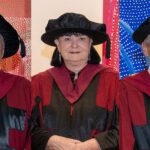A new Curtin University of Technology report calls for a $315 million light rail system to be built in Perth.
The Knowledge Arc Light Rail would link Canning Bridge, Curtin’s Bentley Campus, Technology Park, Victoria Park, Queen Elizabeth II Medical Centre, the new Princess Margaret Hospital and the University of Western Australia.
The plans are part of Professor Peter Newman’s latest report, ‘The Knowledge Arc Light Rail: The next phase in Perth’s public transport’.
“Perth needs a new type of public transport to help it adapt to its growth pressures and light rail can be fitted into the present road structure and provide a fast, clean high capacity system,” he said.
“The proposed route links together the main knowledge centres like pearls along a string, enabling them all to grow substantially without the need for so much parking.
“The new PMH site is planning to have Perth’s biggest car park costing $180 million — this is a waste of money and land.
“The $315 million suggested cost for the light rail could be paid for from parking savings and land development opportunities created.
“Light rail is being adopted by many car-oriented cities in the US as a way to help rebuild their cities with less car dependence and more genuine centres. Light rail is the catalyst for building little cities along its route.
“Infrastructure Australia is funding light rail systems in Adelaide and the Gold Coast through a combination of funding sources and with a strong emphasis on land development opportunities.
“This should be adopted in Perth as the way to make our next stage in public transport happen.”
Professor Newman said the advantages of developing a new light rail system outweighed an improved bus system.
“A larger number of passengers can be carried with fewer vehicles and staff, and the congestion threshold is significantly higher,” he said.
“Commercial speed and timetable reliability are generally higher with rail systems and rail networks are more easily understood than bus systems. These are only some of many advantages.
“While buses are clearly capable of offering high quality public transport services, the choice of rail on routes with the potential for high patronage offers additional synergies.”
This report was produced as part of the Parsons Brinckerhoff – Curtin University Sustainability Policy (CUSP) Alliance.
The full report can be downloaded from: http://sustainability.curtin.edu.au/
Note to COS/Editor: Professor Newman from Curtin University Sustainability Policy (CUSP) Institute and Infrastructure Australia Board Member is available for interviews on Saturday 1 May from 9am to 10am at 24 High Street, Fremantle or on 0407 935 133.


